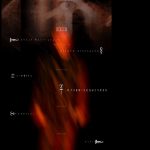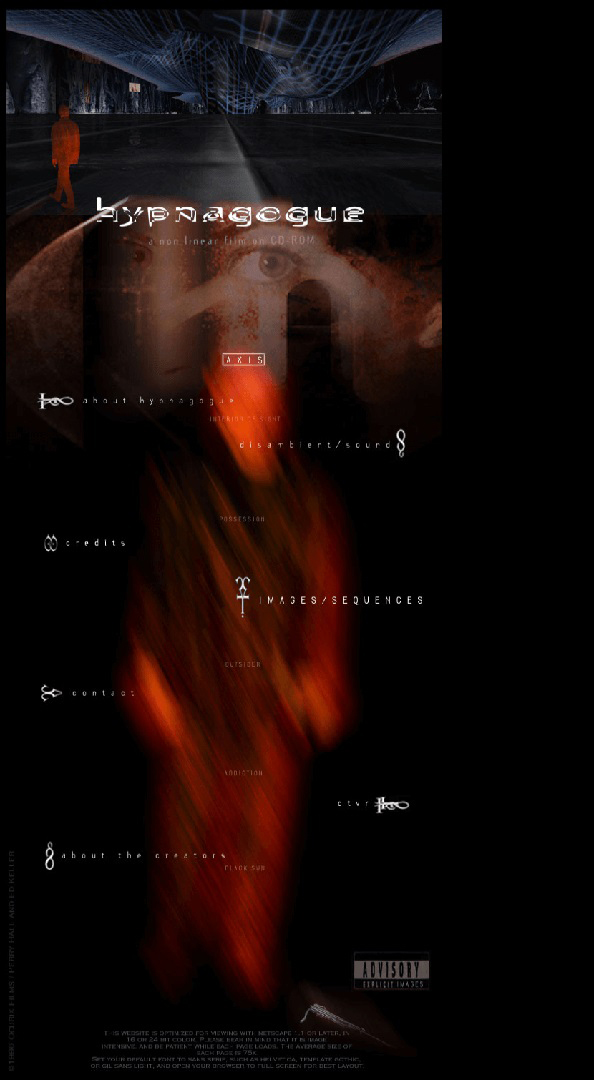Ed Keller: Hypnagogue
Title:
- Hypnagogue
Artist(s) and People Involved:
Exhibiting Artist(s):
Performers:
Symposium:
Artist Statement:
- movement from still to still throughout much of the project;
- in areas of intensity, the stills themselves become activated by the presence of characters or objects;
- in moments of intensity in the paintings, the surface of the work folds into itself to become a nested montage or quasi cinematic QTVR picture plane;
- in key locations one’s point of view is drawn briefly into animations;
- and in the concluding environment, one navigates through the fluid panoramic space of multiple QTVR nodes.
“It will speak a secret language, and leave behind documents not of edification, but of paradox”
—Hugo Ball
Hypnagogue is a collaboration between artist/musician Perry Hall, and architect/multimedia designer Ed Keller, which adopts a multimedia format (authored in mTropolis) suitable for CD-ROM and installations – that of navigable spaces accessible through stills, animations, digitized video, and QTVR. Thirty paintings and eight digital architectural spaces are the sites within which over 80 sound elements (all recorded in 44.1 kHz stereo), written text, live actors and computer generated characters become event sequences that the viewer/listener may interact with. Using a highly detailed, enigmatic, and complex computer generated environment, which the viewer/listener navigates largely at will, an open, non-linear time sequence is developed, problematizing traditional notions of the boundaries between space, sound, image, narrative, and the enunciative and mechanic gradients that establish these categories. The form of Hypnagogue, and its elements, were greatly influenced by a body of work including the collage novels of surrealist painter Max Ernst, the films The Stalker and Solaris by Andrei Tarkovsky, the work of artist Brian Eno and writer Jorge Luis Borges, the architecture of Gaudi, Terragni, Scarpa, and many others. CONCEPT, STRUCTURE AND INTERFACE Navigation (montage) takes place as the viewer/listener mouses over paintings and through spaces on screen. There are several modes of navigation which correspond to varying types of intensity of narrative, image and sound in the project:
Quasi-filmic modulations of the flow of time are accomplished through these alternative techniques of montage. Certain rhythms are set up by the transitions from frame to frame which reflect the partition of time into somewhat linear segments—a division of time which is radically altered in the QTVR spaces. The project uses hybridized painterly, musical, architectural, and filmic techniques to explore a sensibility concerned with intensities and effects while questioning the enunciative machines typically developed in narratives of space, sound, image. For instance, space flows continuously between the architectural sites that contain paintings into the paintings themselves, which are navigated as spaces as well (erasing/questioning boundaries between surface and depth in the picture plane) through enhancement of their innate spatiality and the ability to make scale fluid in the digital realm (most of the paintings themselves are extremely small, ranging from 10″ square to as small as 1 inch square). This transition is accompanied by shifts in the sonic environment, and might include (for example) a series of movements from still to still, to a still frame which one then exits via a Quicktime movie, that leaves one inside a QTVR node, which after a specified period of time transitions one into another space.
Category:
All Works by the Artist(s) in This Archive:
All Works by the Performer(s) in This Archive:
- Perry Hall
- More Art Events from Perry Hall in this archive:

Hypnagogue
[ISEA97]





